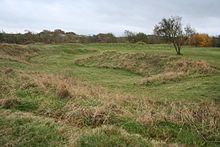Henge
A henge [ hɛndʒ ] (also henge monument ) is a special type of Neolithic earthwork . They are round or oval areas with a diameter of 20-480 m, which were bordered by an earth wall with mostly internal ditches. Most henges have a single trench; a few have two and three concentric trenches or no trenches at all. The term was coined in 1932 by Sir Thomas D. Kendrick (1895–1979), who later became curator for the British Antiquities in the British Museum . He used while the suffix of Stonehenge . The term henge comes from Anglo-Saxon and describes a gate-like structure. Discovered in 1925, Woodhenge , a Class I Henge (with one entry) and with seven concentric post rings in the center, was named because of its resemblance to Stonehenge.
One, two or four (rarely) passages through the wall lead to the interior. There can be portals, stone circles , four- poster stone circles, monoliths , pits, individual posts, arrangements of posts or menhirs and grave sites, the latter often being added later. In view of the rather unsuitable arrangement of the inner ditch (rare in Ireland ) and the outer mound for defense purposes , one assumes a ritual function of the henges; the walls possibly had the purpose of shielding what was going on inside from the outside world. The Henges ring trenches were difficult to carve out in areas with stony ground. Only the ring of Brodgar , Orkney , has a circular moat carved into the sandstone underground. Henges like Durrington Walls , a Class II Henge, are settlements. Most of the henges are largely leveled today.
Occurrence
120 Henge monuments can be found in large numbers mainly in the south of England, but also in Ireland and other regions of the British Isles including Scotland ( Kilmartin , Machrie Moor , Normangill ) and the Orkney . as well as in Galicia ( Henge von Roda ). Unlike causewayed camps or hillforts , they were mostly built on the plain, often near rivers and fertile farmland. Castleruddery is a comparatively small henge in the west of County Wicklow in Ireland.
to form
Atkinson defined three classes ( classes ) of Henge. All have only one wall. Furthermore:
- Class I One entrance and one moat.
- Class IA One entrance and double circle of moats - the memorials lie between the Rivers Ure and Swale in North Yorkshire
- Class II Two opposite entrances, a ditch.
- Class IIA Two opposite entrances, two or more trenches.
- Class III Four opposite entrances, one trench.
Atypical henges have the moat outside the wall (Mayburgh). The large henges are called Giant Henges .
Dating
Henges are assigned to the late Neolithic Age with Grooved Ware ceramics. In Stonehenge , the famous monument in Wiltshire , activities of the bell-cup culture and the early Bronze Age have been demonstrated. In its early form, Stonehenge is what is known as an atypical henge, because the moat runs outside the wall. The use of Henges generally ends around 2500 BC. Chr.
Superhenges
- Avebury , 420 m in diameter, north of Stonehenge on the Salisbury Plain
- Durrington Walls on the Salisbury Plains
- Marden Henge , oval, 450/330 m, in Wiltshire
- Mount Pleasant in Dorset
- Waulud's Bank in Bedfordshire
See also
literature
- RJC Atkinson: The henge monuments of Great Britain . In: RJC Atkinson CM Piggott, NK Sandars: Excavations at Dorchester Oxon . First report. Ashmolean Museum, Oxford 1951, pp. 81-107.
- Warwick Bray, David H. Trump (Eds.): The Penguin Dictionary of Archeology. 2nd edition. Penguin, London 1982, ISBN 0-14-051116-4 (numerous editions).
- Rodney Castleden: The Stonehenge people. An exploration of life in Neolithic Britain 4700-2000 BC. Routledge, London et al. 1987, ISBN 0-7102-0968-1 (also: ibid. 2002, ISBN 0-415-04065-5 ).
- Ian Harding: The Henge Monuments of the British Isles: Myth and Archeology 2004, ISBN 0-7524-2508-0 .
- Julian Thomas: Understanding the Neolithic. Revised 2nd edition. Routledge, London et al. 1999, ISBN 0-415-20766-5 (Reprint: ibid 2003).
- A. Whittle: The Neolithic Period. In: John Hunter, Ian Ralston (Eds.): The archeology of Britain. An introduction from the Upper Palaeolithic to the Industrial Revolution . Routledge, London et al. 1999, ISBN 0-415-13587-7 (Reprint: ibid 2002).
Web links
- Definition (last accessed on December 17, 2012)
- Henge Monuments (last accessed December 17, 2012)
- Maelmin - picture of the reconstruction of a henge - work in progress (last accessed on December 17, 2012)
- Image - in more advanced state (last accessed December 17, 2012)
Individual evidence
- ^ University of Sheffield: Sheffield archaeologists unearth huge settlement at Stonehenge, January 31, 2007


